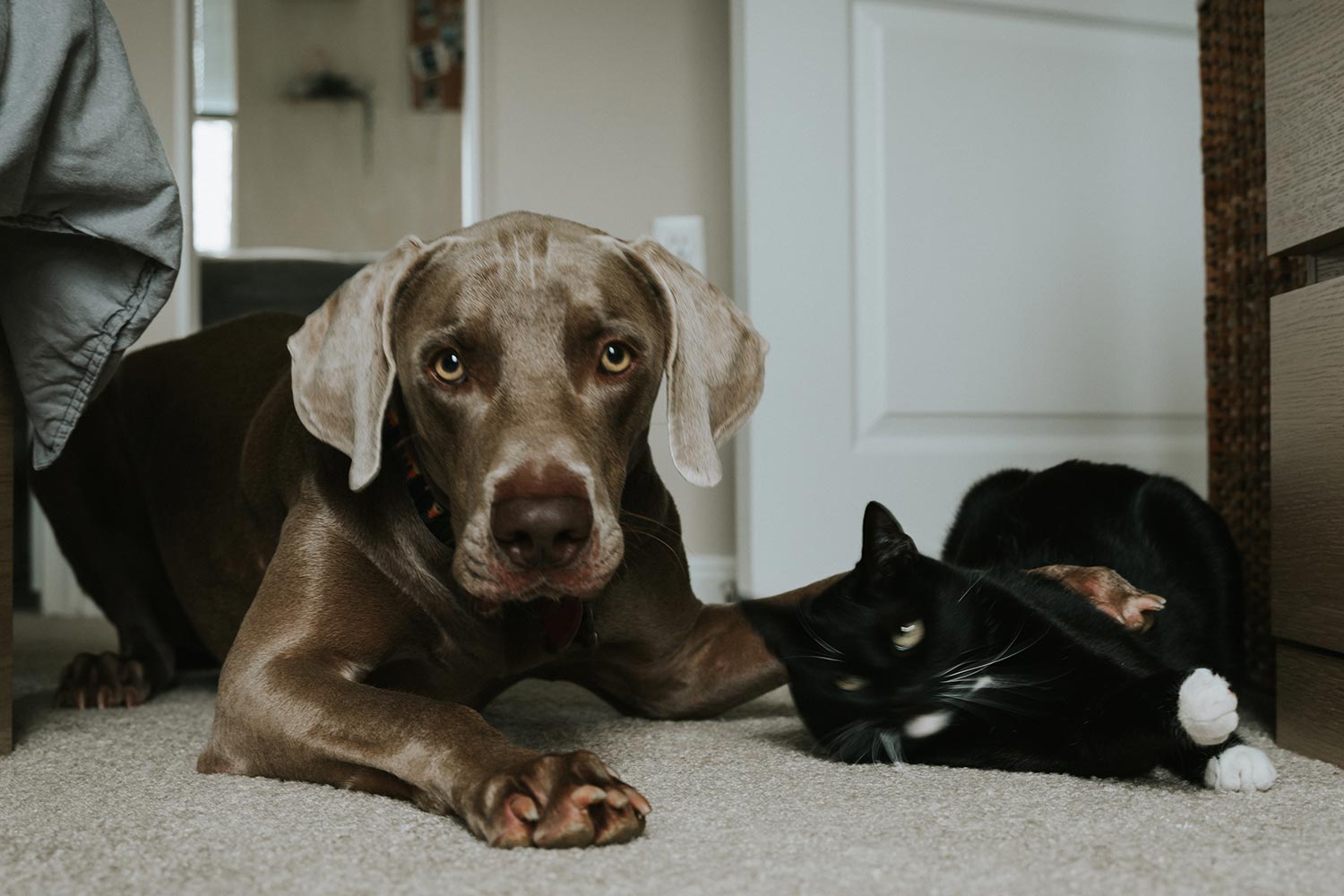Ensuring Dogs and Cats Get Equal Scratch in Decision-making
Every organization is made up of cat people and dog people. This framework can help with equity and inclusion in decision-making processes.

Seven steps for creating an inclusive and equitable task process.
Are you a dog or a cat person? I don’t mean your preference for a pet. If you show up to a meeting barking and clawing to make your point, you might be a dog person. If you lay back during the decision-making process but circle back to pee on outcomes you don’t like, you may be a cat person.
We can use this dog/cat framework to better understand equity and inclusion in the decision-making process. The dominant business model often rewards alpha dogs who bark the loudest and make quick decisions. These meeting structures, designed for speed and efficiency, don’t leave space for cats, who often need more information and time to process before they are ready to offer input. Our systems are weighted towards those most comfortable giving opinions verbally while excluding those for whom written responses may be the best way to express themselves.
Every organization is made up of cat people and dog people, and some shift from day to day. I may show up as a doberman on Monday morning and roll in as an orange tabby by Friday. When I joined Animal Allies Humane Society in 2015, the rottweilers were in full command. Meetings quickly devolved into shouting matches and often ended in tears. Most importantly, the alpha dogs’ ideas did not receive buy-in from the cat people and went nowhere.
So how do you facilitate decision-making so that everyone has equal voice and agency? Thankfully, there is a way to set the table so that everyone can feast. Leveraging Edgar Schein’s task functions in groups process to present issues removes the demand for immediate reaction/action and creates a safe space where equity and inclusion thrive.
So, how does it work? Task functions in groups creates a framework for making collective, informed decisions. One thing that can really compromise inclusive and equitable decision-making is jumping straight to opinions (barking) before all the information has been gathered. Haste makes waste when you don’t make space and take advantage of everyone’s unique perspective. Inclusivity needs structure to survive and thrive.
7-Steps to Creating an Inclusive and Equitable Task Process
- Step 1: Initiate the idea, change, or issue.
- Team members initiate an idea, change, or issue at any time prior to the meeting by adding a brief description and supporting documentation to the agenda under “New Items for Discussion” (after the previous business and consent items have been addressed). Think of it as a heads up. To reduce stress, provide a negotiable timeline for action items that don’t require an immediate decision.
- Step 2: Seek and give information.
- Managers must engage team members for feedback prior to the next meeting— every voice counts! Leaders are expected to consolidate input and come prepared to deliver their team’s strong ideas, loosely held. During the meeting, a facilitator creates the space for this give and take before allowing members to offer opinions. Dominant voices are the first to rush the stage, but it takes a choir to make a concert.
- Step 3: Seek and give opinions.
- At a point where the facilitator feels the group has enough information to begin dialogue, they may open up the floor for all to offer their thoughts. Feedback should also be solicited through written channels such as email or chat for those who are less comfortable speaking up in a group setting. Utilizing an online platform can facilitate this in real time, and a moderator can help report out. Team members may also provide their input one-on-one to a trusted colleague who can convey this to the group.
- Allow time between meetings, if possible, for open comment. And really, how many decisions are that urgent, beyond taking the dog out when they really need to go?
- Step 4: Take time out to clarify.
- A team member may call a time out during the discussion to clarify a point. Are there implicit biases in play? Does this align with our mission? Could this be a presenting problem (tip of the iceberg)? The facilitator should return to information seeking and giving (Step 2) if things are getting fuzzy or emotionally charged.
- Step 5: Elaborate on the proposed changes and/or conclusions.
- The facilitator should note and share any adjustments or additions to the original proposal. Discussion and fresh data often shift the original concept. When the processors (cat people) are fully included, what may have been a one-sided solution becomes multi-faceted and adaptive.
- Step 6: Summarize the proposal.
- When the group feels they have everything they need to move forward (insert awkward pause to allow courageous cats to chime in), the original initiator or facilitator should summarize the proposal, perhaps by making a motion under Robert’s Rules. This person should ask if there are any other considerations or information needed. Let the room breathe.
- Step 7: Test consensus.
- Okay! Now you’ve got ourselves an idea that has been co-created by the entire team no matter what side of the kennel they came from. The specifics of testing consensus should suit the culture of the organization. If you operate through a more formal lens, voting by rule of majority may be an option. However, you might consider if a voice vote would make the cats uncomfortable and if a secret ballot would prevent groupthink.
- Whichever way your organization recognizes consensus be sure to ask the following questions:
- • Is everyone on board?
- • If not, what additional information is needed?
- This is the point where you might consider returning to Step 2 and repeating the process as necessary. Collaborative decision-making requires patience and practice. Remember, if you smell cat pee, you may have moved too quickly or skipped a step.
Following Schein’s task functions for group allows organizations to make decisions through true collaboration rather than conquest. Downshifting the pace of change and decision-making can be a real challenge for individuals and organizations operating within the western dominant business culture. It takes time to create the space for everyone to bring their authentic selves to the table.
Equity and inclusion can only flourish in a culture that honors both dogs and cats. Dogs can be allowed to bark and jump when bringing their strong ideas as long as we also encourage cats to process, reflect, and give well-informed opinions. If you follow the 7 steps and still find residual resistance from cats who do not fully engage, use one-on-one coaching sessions to surface and address lingering barriers to participation. If you are confident you have created ample space for input then hold cats accountable if they follow old paths of participation.
All it takes is a framework and a little patience, just like training a puppy. We all know you can’t train a cat, but you can create a culture where the team’s contributions add up to a better future for all pets and people.
For further reading:
Facilitative Process Interventions Task Processes in Groups, Chapter 13, pp.286-308, E. Schein Organization Development: A Jossey-Bass Reader
You might also like:
- When the Board Becomes the Problem: Reclaiming Power in Nonprofit Leadership
- Why Human-Centered AI Adoption Matters for Nonprofits
- The New Sheriff in Town: Tips for Successfully Leading a Nonprofit Team (that Someone Else Built)
- When the System Fails Quietly: What I’ve Learned from Sitting Between the Frontline and the Data
- A Board Member “Contract”
You made it to the end! Please share this article!
Let’s help other nonprofit leaders succeed! Consider sharing this article with your friends and colleagues via email or social media.
About the Author
Daryl Yankee has worked for over two decades as an internal consultant helping NGOs. He has observed firsthand how visuals spur dialogue and invite a larger audience to join in the work. Daryl holds a master’s degree in the science of organization development from Pepperdine University. He specializes in crafting strategic plans that are adaptive and allow for innovation in today’s increasingly complex world. Daryl enjoys engaging with a wide variety of changemakers as a board member of the Minnesota Council of Nonprofits. When he’s not helping others change the world, Daryl can be heard playing his guitar for friends and fellow travelers.
Articles on Blue Avocado do not provide legal representation or legal advice and should not be used as a substitute for advice or legal counsel. Blue Avocado provides space for the nonprofit sector to express new ideas. The opinions and views expressed in this article are solely those of the authors. They do not purport to reflect or imply the opinions or views of Blue Avocado, its publisher, or affiliated organizations. Blue Avocado, its publisher, and affiliated organizations are not liable for website visitors’ use of the content on Blue Avocado nor for visitors’ decisions about using the Blue Avocado website.








Me. Yankee (!?) Excellent piece. Wonderful metaphor. Important ideas about decision-making- and advocacy – particularly in the NGO sector. Will use and reference prolificly, with attribution
Sean Moore
Advocacy School
Ottawa
That all sounds great and ideal, and I think most of us strive to create that sort of equitable and inclusive environment. The problem, of course, is that in most organizations there isn’t adequate time for anyone to engage in that sort of Plan-in-Advance, followup-with-each-individual, reframe-the-problem-and-propsed-solutions, re-convene-to-revisit-ideas-and-solutions process unless we’re focusing on a one-time annual retreat or something of that nature.
Challenges, timely decisions, and quick & decisive action are the name of the game in most situational applications of real-life decision-making. Too much processing ends up with confusion among staff, polarization, behind-the-scenes-office-politicking, or, in my case here, too many hyphenated phrases. 🙂
I totally support the ideals presented here; they’re just not always practical, and yes, at times the barking dogs drive away the more cunning cats. The key is not to let the cunning cats poison the well of the group decisions that have been reached. It’s a challenge, indeed.